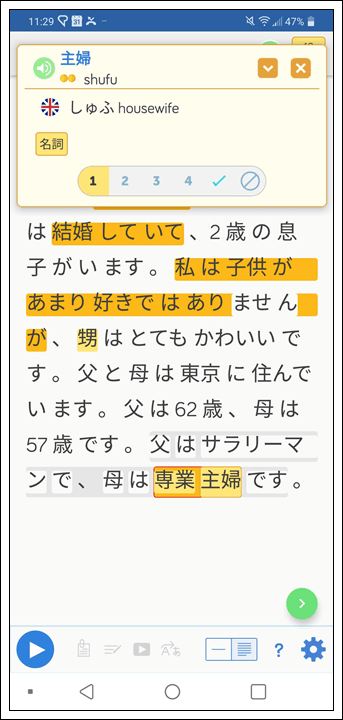Members of Your Family in Japanese
When learning a new language and meeting new people, one of the most common topics you will encounter will undoubtedly be about your family.
Who do you live with? What are your parents like? How many siblings do you have?
The topic may seem simple enough, however in Japanese, the way to talk about it may be a little trickier than expected. This is because Japanese, as we know, is a language that incorporates honorifics and varying levels of politeness depending on who and what you are talking about. That being so, the words you will use to describe family will also change depending on the situation.
Unlike English, Japanese family members have different terms depending on whether you are talking about your family or a friend’s, and if you are talking to a friend, teacher, coworker, or boss. The difference could be as simple as adding an honorific prefix (o-, go-), or as complex as using a completely different word.
Looking at the chart below, you will see there is one main thing to keep in mind when talking about family: whose family it is you’re talking about!
When talking about someone else’s family, the most common way to formalize it is by simply adding the prefix お (o-) or ご (go-), or adding the suffix ~さん(~san). In most cases, adding –san will suffice, but in situations where you need to be super formal (such as talking to a boss or authority figure), you can (and should!) exchange さん with さま (for example, when talking to a friend about their wife, you can say 奥さん(奥さんokusan) but when talking to a boss about his wife, you should probably say 奥様 (おくさまokusama)for added politeness)!
It should also be noted that these rules of extra formality also apply to customers when in a store/business setting in which you are an employee or staff. In Japan, customers are regarded as higher than the staff, so you may notice that store employees always use the politest form of language with them. The same rule applies to strangers and people that you are not familiar.
The best rule of thumb is to always aim for the highest level of politeness when talking about someone’s family in Japanese.
Before I show you the chart below, here are a few notes:
Variations
There are two rows for “my family” because some words have a second, less casual form, similar to how in English, “mother” is the most common/standard form of the word, but you can also say “mom,” “ma,” etc. (Note that not all words have a variation however, hence the blanks).
Higher Formality
As mentioned above, the honorific row shows the standard polite form with the suffix さん (san), but you can exchange that さん for さま (sama) for a higher level of politeness.
Super Casual
Similarly, a word can be made super informal by removing the おand changing さん to ちゃん (chan); this is often done when speaking about family within the same family (for example, talking to your mom about your sister).
Example: お父さん (otousan) can drop the o- and take –chan instead of –san, becoming 父ちゃん (tou-chan), a super casual way of saying father (like saying “daddy” or “pops”).
| FAMILY MEMBER NAME | VARIATION/ “MY FAMILY” | CASUAL/ “MY FAMILY” | HONORIFIC/ “YOUR FAMILY” |
| GENERAL TERMS | |||
| Family | 家族 かぞく kazoku | ご家族 ごかぞく go-kazoku | |
| Parent(s) | 父母 ふぼ fubo | 両親 りょうしん ryoushin | ご両親 ごりょうしん go-ryoushin |
| Sibling(s) | 兄弟 きょうだい kyoudai | ご兄弟 ごきょうだいgo-kyoudai | |
| Grandparent(s) | 祖父母 そふぼ sofubo | *refer to individually | |
| Grandchild(ren) | 孫 まご mago | お孫さん おまごさん o-mago-san | |
| Children | 子供 こども kodomo | お子さん おこさん oko-san | |
| Married Couple | 夫婦 ふうふ fuufu | ご夫婦 ごふうふ go-fuufu | |
| Fiancé | 婚約者 こんやくしゃ kon’yakusha | 婚約者さん こんやくしゃさん kon’yakusha-san | |
| Relative(s) | 親戚 しんせき shinseki | ご親戚 ごしんせき go-shinseki | |
| ~ in law | 義理の~ ぎりの~ giri no~ | 義理の~さん ぎりの~さん giri no~san | |
| SPECIFIC TERMS | |||
| Mother | 母 はは haha | お母さん おかあさん okaa-san | お母さん おかあさん okaa-san |
| Father | 父 ちち chichi | お父さん おとうさん otou-san | お父さん おとうさん otou-san |
| Son | 息子 むすこ musuko | 息子さん むすこさん musuko-san | |
| Daughter | 娘 むすめ musume | お嬢さん おじょうさん ojou-san | |
| Sister (older) | 姉 あね ane | お姉さん おねえさん onee-san | お姉さん おねえさん onee-san |
| Sister (younger) | 妹 いもうと imouto | 妹さん いもうとさん imouto-san | |
| Brother (older) | 兄 あに ani | お兄さん おにいさん onii-san | お兄さん おにいさん onii-san |
| Brother (younger) | 弟 おとうと otouto | 弟さん おとうとさん otouto-san | |
| Wife | 家内 かない kanai | 妻 つま tsuma | 奥さん おくさん oku-san |
| Husband | 夫 おっと otto | 主人 しゅじん shujin | ご主人 ごしゅじん go-shujin |
| Grandmother | 祖母 そぼ sobo | お婆さん おばあさん obaa-san | お婆さん おばあさん obaa-san |
| Grandfather | 祖父 そふ sofu | お爺さん おじいさん ojii-san | お爺さん おじいさん ojii-san |
| Aunt | 伯母 おば oba | 伯母さん おばさん oba-san | 伯母さん おばさん oba-san |
| Uncle | 伯父 おじ oji | 伯父さん おじさん oji-san | 伯父さん おじさん oji-san |
| Cousin | 従兄弟 いとこ itoko | 従兄弟さん いとこさん itoko-san | |
| Niece | 姪 めい mei | 姪子さん めいご meigo-san | |
| Nephew | 甥 おい oi | 甥子さん おいごさん oigo-san | |
Speaking About Family Members in Japanese
Now that you know how to say each family member’s name, it’s time to learn how to use them properly in a sentence. In English, you could simply say either “MY mother” or “YOUR mother,” however in Japan, remember, it is important to keep in mind WHO you are talking to.
Japanese people do not usually use the word “you” (あなた, anata) in conversation, as it is considered too casual. In most cases, they simply use the other person’s name plus さん at the end.
So if I were talking to Joe about his wife, though in English I could easily say “Your wife” without sounding rude, in Japanese, I would say ジョーさんの奥さん (Joe-san no oku-san), which literally translates to “Joe’s wife.”
In other words, it is common and more polite to refer to someone in third-person, even when talking to them directly.
Example: (When talking to Joe):
ジョーさんの奥さんは優しいです。
Your (Joe’s) wife is kind.
Higher Formality:
ジョーさんの奥さまは優しいです。
Your (Joe’s) wife is kind.
If I were telling Joe about MY wife, I could say 私の妻 (watashi no tsuma, literally “my wife”), however in a casual conversation in which the subject is already known (i.e., Joe knows you are talking about your own family), then I could eliminate the 私 and simply say 妻.
Example:
私の妻は優しいです。
My wife is kind.
妻は優しい。
My wife is kind.
(Super casual, subject is implied but not stated).
In summary, there are many ways to refer to friends or family in Japanese, but the defining rule on which term to choose is ultimately depending on the level of authority of the person you are talking to, and whose family you are talking about.
It can be a little confusing at first when memorizing words with different variations, and which ones are preceded with お or ご for politeness. But when in doubt, always remember the suffix さん and さま, which can be added to any of the terms above – it never hurts to be a little extra polite!
Learn Japanese family member vocabulary faster
A great way to learn Japanese family member vocabulary is through context, or reading short dialogues.
But where can you find them?
LingQ of course.
LingQ has 100s of Japanese lessons including ones that talk about family. Not only that, using LingQ, you can listen to the audio that’s been recorded by native Japanese speakers, look up your words, save them, review them, and more. Below’s a quick snapshot of what one of the lessons looks like on LingQ’s mobile app (iOS and Android).

As you can see, you can listen to the audio, look up words, and read along anytime, anywhere. LingQ lets you learn using content you love as well thanks to it’s unique import feature. This allows you to import content from YouTube, anime, music, and much more. LingQ’s guide to importing can be found here, so check it out.


